Uni High Students Research Heat Pipes as Part of POETS’ RET Curriculum Development
May 31, 2017
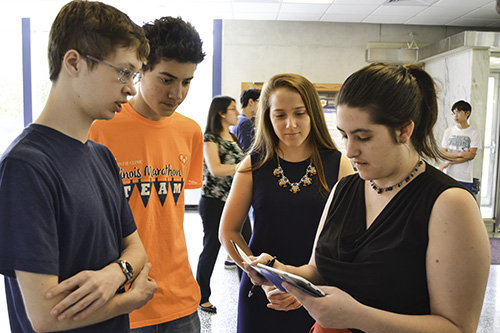
Kate Dahlke, a grad student judge (right), reviews the video a team of Uni High students made as part of their research project.
Although they might not have realized it, during the spring 2017 quarter, students in David Bergandine’s three chemistry classes at University Laboratory High School (Uni High) did research projects about heat pipes that were part materials engineering, part physics, and part chemistry, along with a lot of science. While testing twelve different variables about heat pipes, they not only gained a lot of general knowledge related to heat flow and heat transfer, but gained some very in-depth knowledge about the specific area they researched. Plus, in addition to learning what research is like, his students got to present their research at POETS' 2017 High School Student Research Symposium on May 23rd.
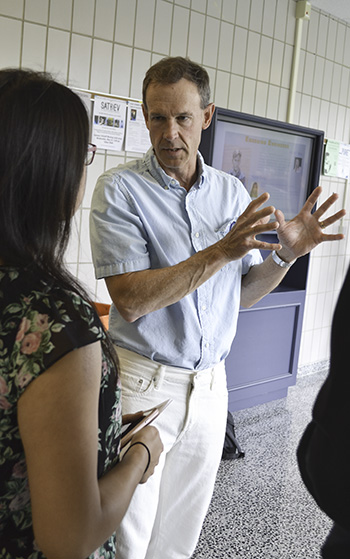
David Bergandine (right) discusses his heat pipes lesson with POETS' Jessica Perez.
Bergandines’s heat pipes research lesson came about as a result of his participation in the NSF-funded POETS’ (Center for Power Optimization of Electro-Thermal System) RET (Research Experience for Teachers) program the summer of 2016. A key aspect of the RET was that he and three other local teachers were to develop curriculum during the summer which they would then implement during the school year. “Our goal,” Bergandine explains, “was to create some lessons that can be used at the middle school and high school level related to heat flow, heat transfer—heat problems that would perhaps show up in electronic circuitry or mechanical heat exchange.”
Bergandine says his students’ research this spring was a spinoff of his summer focus on models that involved electricity and resistance: “So we were looking at things like how much heat would develop in a circuit depending on the wire size…The idea was to maybe have a lesson involving students modeling some sort of mechanism that they would build and then test to see if there was a heat flow problem somewhere within the circuit or within the mechanism.”
The heat pipe lesson was born when Bergandine and Joe Muskin, POET’s Education Coordinator, visited a professor who showed them a heat pipe being used to cool electronic circuitry, and he thought, “Oh, that’s interesting. Maybe we can try to build one and see if it would work?”
Since later in the summer, he actually built a model heat pipe—and it worked—he decided that heat pipes had enough inherent variables to provide a high school research project. “It turns out there are about a dozen different things that could be varied that students could test,” he says. “So, we settled on that."
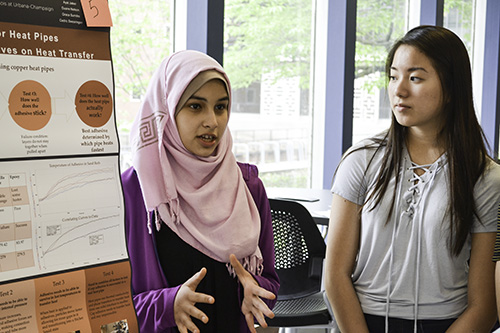
A student explains her team's research findings.
So as part of his curriculum development, Bergandine had his chemistry classes research relevant variables when designing a heat pipe, related to: “What are some things that are important to a heat pipe?”
First students developed a list of things they could vary. After observing and researching heat pipes, they came up with about a dozen factors that they could vary to test.
Next, Bergandine grouped his students based on their interests: which of the variables they were most interested in, and which of five skills needed to complete the project they were good at: designing the experiment, conducting the experimentation, explaining their process and results scientifically, making a poster, and making a video.
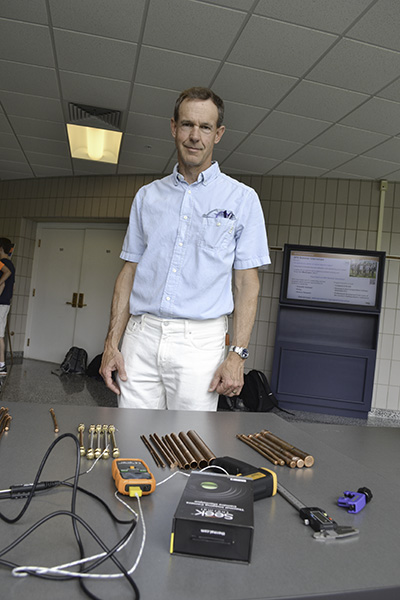
David Bergandine by some of the equipment students used, along with some of the pipes they tested.
“Then I tried to group people based on their interest in the topic, plus the skill set that they brought,” he explains. “I think we ended up creating fairly effective groups,” he says. There were twelve groups all total, four in each of his three classes.
Next, his students began testing a number of variables regarding heat pipes. These included length; width; diameter; conductivity of the material itself, depending on how much mass was present; whether a solid material would conduct better than a hollow pipe; different metals; different fluids on the inside; and using wicking materials on the inside. Bergandine indicates that his students also tested to see if the volume of liquid mattered, going from no liquid inside to 25%, 50%, 100%, to see if they still got a certain performance. His students also tried water versus ethanol, and then mixtures of water and ethanol.
Regarding the lesson's multidisciplinary nature, Bergandine calls it “really heavy-duty engineering in the sense that you have to build something that works, and that’s not always what a scientist does. But, on the other hand, we were also doing science in the sense that we were just discovering how materials behave."
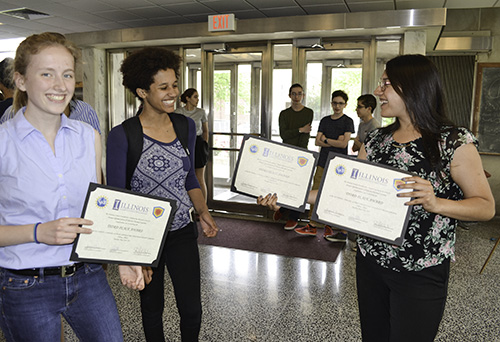
Jessica Perez (right) awards some students their third-place certificate.
Also key to the lesson was the opportunity for students to present their research. The teams each created a poster and a video about their study, then presented them at an end-of-the-quarter poster session on campus on May 23, 2017. Because POETS is seeking to create short-term research opportunities and competitions for K-12 students, the poster session was also a competition. A group of POETS' graduate students served as judges, watching as each team of students presented their research via posters and videos, then judged the teams' work based on the quality of the research. Teams who won 1st, 2nd, and 3rd place got first pick of the numerous prizes that were available. However, every student received a certificate and got to choose a prize.
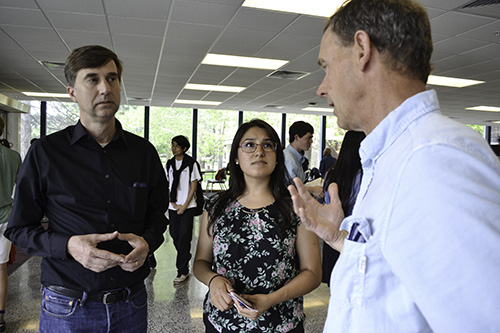
Left to right: Joe Muskin and Jessica Perez converse with David Bergandine about his students' research projects.
Jessica Perez, POETS’ Associate Director of Education and Inclusivity, explains how Bergandine’s project is related to the RET’s curriculum development goal, calling it, “Research to see what variables are important. And then knowing this information, David is going to figure out ‘How can I develop this into a piece of curriculum?’” She goes on to explain that the project isn’t a formal curriculum, but more like a research project or research prompt. “This is actually a part of the curriculum development,” she says. “The students helped do that because they are trying to figure out, ‘What are the important questions to ask?’ and ‘What things matter and what things don’t?’
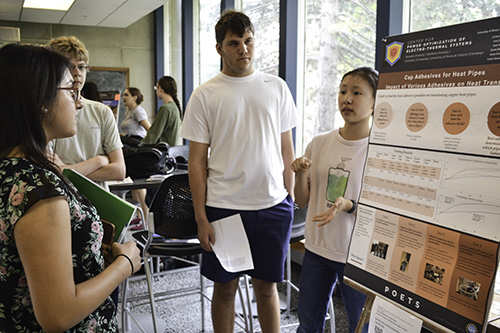
POETS' Jessica Perez (left) listens as a team of students discuss their research.
POETS’ goal in fostering curriculum development through its RET, according to Perez, is “to give students the opportunity to do project-based learning. So, by them doing these sorts of things, they learn how to run experiments, how to ask the right questions. The hope is that by them engaging in this, maybe they will start getting interested in science and engineering. They’ll gain confidence through going through this process.”
She adds that in addition to the impact on the students themselves, it’s an opportunity to disseminate POETS research: “Additionally, it’s great from a RET perspective because that means that we are training RET teachers to bring POETS-related research into the classroom, and they are actually implementing it. The work that David Bergandine did during the summer is already impacting almost seventy different students. Their work is going to have an effect on even more people once the curriculum develops. So, that’s sort of the impact that we want.”
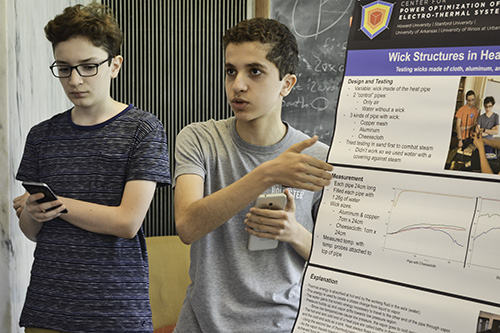
One of Bergandine's students presents his team's research on wick structures in heat pipes.
Bergandine adds that his students also learned a lot of basic knowledge about thermal properties and materials and heat flow and phase change, plus they became specialists in one of those areas.
"Well, they start off knowing virtually nothing about a topic, and then they end up knowing a lot about their own area, plus they know enough that they can easily interact with any of these other groups and quickly understand what it is that they were doing…As individuals, they become sort of specialists in one area...capable of talking about it, presenting it, and so on."
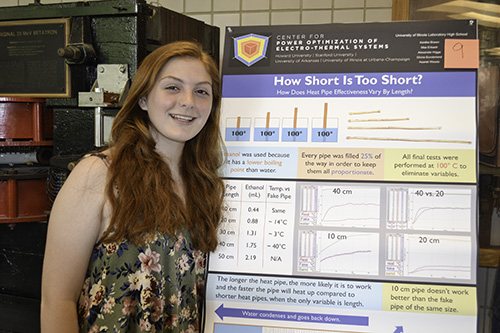
Gloria Sunderland by the research poster she designed.
One student who learned a lot through the project was Gloria Sunderland, a sophomore at Uni High, who indicates that her group did length of the pipe as their variable. While they had “sort of inconclusive results,”(she said their 10 cm. pipe “didn’t really work at all"), she acknowledges that, "We did see that as they got longer they tended to work more effectively."
She reports that, they “had to do a lot of research like the laws of thermodynamics and just heat pipes in general to see how they worked. Then after we figured that out, then we actually had to make them and actually heat them up with the ethanol in the pipes and then cap them so that there would be pressure."
Sunderland also gained some insights about research through the project: "I learned that you can build a lot of knowledge through research and through testing things in real life. Hands-on experience does help you learn and really internalize the knowledge that you’re working on."
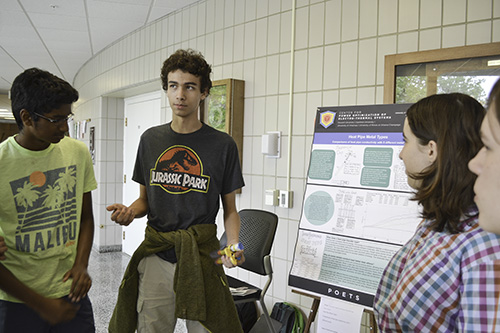
Uni High student Harmen Alleyne (center) explains his findings on the effectiveness of metal heat pipes.
Another student, Harmen Alleyne, a sophomore at Uni High, says his group tested the relative effectiveness of different metals when constructing heat pipes. Their results? Alleyne says copper is the best and stainless steel is the worst in terms of conducting heat.
He also learned a lot about heat pipes through the project.
“When Mr. Bergandine started the project, we had no idea how to construct a heat pipe. He didn't tell us or anything. So, we had to research how to make a heat pipe, research what kind of working fluids we can use and which ones we should use and how the different metals react and why they do that. We had to just research almost everything for this project. So, throughout the entirety of the project, we learned almost all of the workings of a heat pipe."
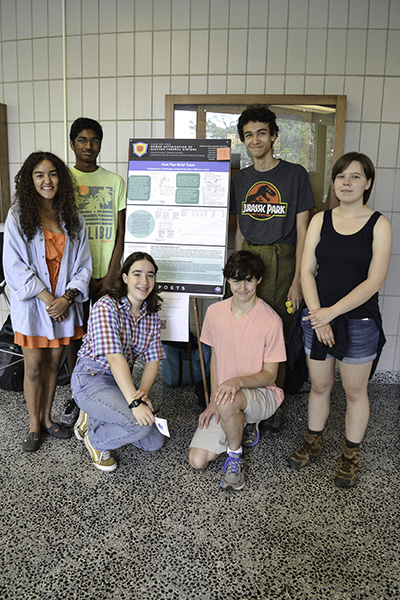
Harmen Alleyne (just right of the poster) and his team of fellow Uni High student researchers.
Alleyne thought the project was fun and "a nice break because we have finals, and that's just studying, studying, studying. This took an entire quarter of work and spread out over a quarter it didnt feel like it was a pressing thing that we had to do for a final grade...It was just kind of a fun project where you got to be with your friends.”
According to Alleyne, a lot of cross-group collaboration also took place, as people learned vicariously through the research being conducted in other groups. “People were talking across groups about how they did certain things,” he admits. “Like maybe someone would ask, 'What working fluid are you using?' and someone would say, 'Oh, I'm using ethanol, because it has a lower boiling point than water,' and then the other person says, 'Oh, that makes sense. I should probably use that since my heat pipe is not working too well.’ So, things like that. I'm pretty sure everyone completed it. Several people didn't like that their heat pipes weren't working, but they asked around and eventually everyone got their heat pipe to work. If not, at least they figured out how the heat pipe should work.”
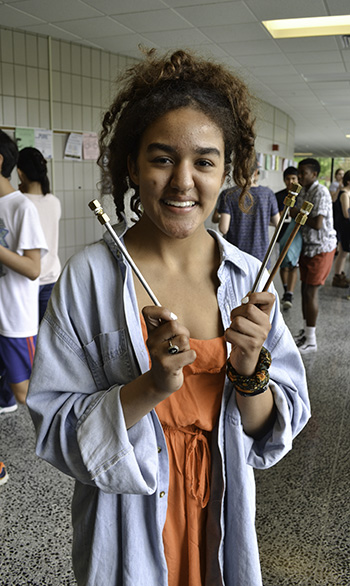
Tina Wayne exhibits some of the heat pipes they tested.
Another student, sophomore Tina Wayne, says she learned about heat pipes and how they conduct energy. She also learned how metals' ability to conduct heat is related to their molecular structure. “I learned how metals' valence electrons impact how they conduct heat. I learned why we use the things that we do within our house.” For example, she learned that copper pipes are used for the most part in houses and in electronics because they have the highest thermal conductivity, and that aluminum pipes are a close second, as are pure metals. “Pure metals should perform better due to having more free valence electrons versus alloys."
Wayne says that during the project, she learned about materials engineering, but some economics too: “My part was explaining why the heat pipe performed as it did. So, I went through a lot of different sites that both sold the different types of metals, and I went through research at different universities. So, I got to see the different type of academic standpoints versus economic standpoints and the viability of both."
Regarding copper being a good heat conductor, Wayne, agrees, but, based on the cost, suggests, “Or aluminum, which is a more affordable type of metal. But, the copper and aluminum were the best and steel and brass should not be used. Steel should definitely not be used as a heat pipe due to it being an alloy and having a low thermal conductivity.”
Wayne admits that she enjoyed the research. “I like doing research, she admits. “I had many questions going into the project, and through doing the research, I was able to answer my own questions and explain it in my own terms so that I could explain it to another person."
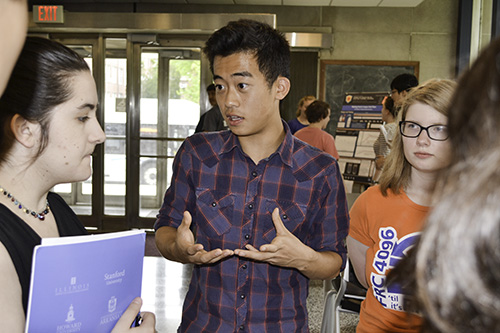
A Uni High student presents his team's research to Kate Dahlkem one of the POETS grad student judges.
The students weren’t the only ones who learned some things; Bergandine did too: “I learned that kids are fairly adaptable, and they’re naturally curious. If you give them objects that they can truly experiment with, they really will.” Something else he learned? “You can do some pretty significant scientific research with things that you could walk to the hardware store and buy.”
Grateful for the support and the impetus POETS provided, Bergandine says POETS helped “supply us with some materials and really get us started, because that’s a sort of barrier that many schools might have. You just need some of those materials and maybe a little bit of insight just to get you started on a project.”
He also hopes to “continue working with organizations like POETS and other groups on campus that would like to collaborate with us and give our students authentic research opportunities in the classroom, but also use those research opportunities to ensure that students are doing real science and learning what science is all about and not just learning about science."
Story & photographs by Elizabeth Innes, Communications Specialist.
For additional articles about POETS, see:
- Local 8th Graders Build Solar Cars Courtesy of new POETS' RET Curriculum
- POETS Seeks to Change the Attitudes, Shape of Students in the STEM Pipeline
- POETS, New NSF Center at Illinois, Poised to Revolutionize Electro-Thermal Systems
- POETS website
More: POETS, University Laboratory High School, 2017
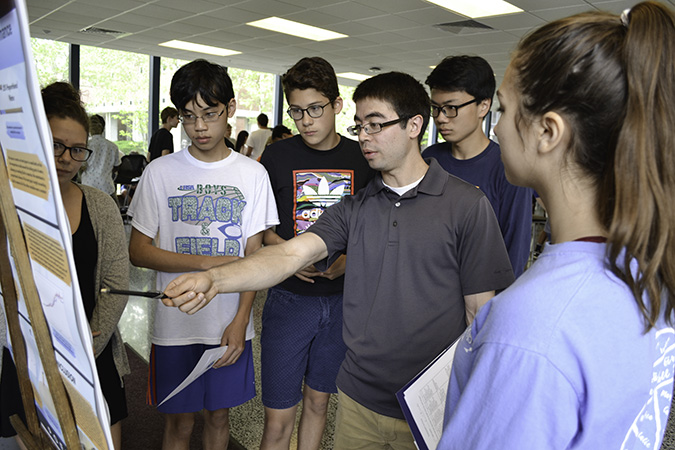 Leon Dean, one of the grad student judges (center), discusses a team of students' research project with them.
Leon Dean, one of the grad student judges (center), discusses a team of students' research project with them.












.jpg)
















